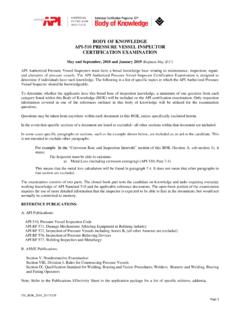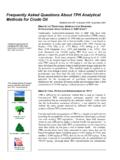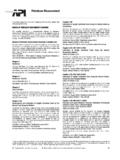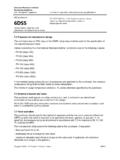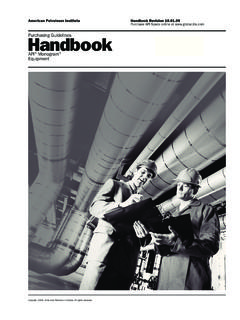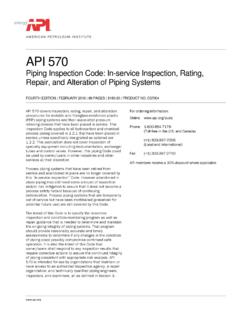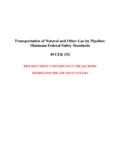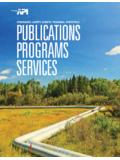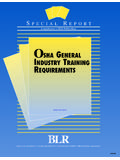Transcription of 29 CFR 1910 Occupational Safety and Health …
1 Occupational Safety and Health standards ( osha ). 29 CFR 1910 . THIS DOCUMENT CONTAINS ONLY THE SECTIONS. NEEDED FOR THE API 1169 ICP EXAMS. Sections Subpart H Hazardous Materials Process Safety management of highly hazardous chemicals. APPENDIX A TO LIST OF HIGHLY HAZARDOUS CHEMICALS, TOXICS AND REACTIVES. (MANDATORY). APPENDIX B TO BLOCK FLOW DIAGRAM AND SIMPLIFIED PROCESS FLOW DIAGRAM. (NONMANDATORY). APPENDIX C TO COMPLIANCE GUIDELINES AND RECOMMENDATIONS FOR PROCESS Safety . MANAGEMENT (NONMANDATORY). APPENDIX D TO SOURCES OF FURTHER INFORMATION (NONMANDATORY). Subpart I Personal Protective Equipment General requirements. Eye and face protection. Respiratory protection. APPENDIX A TO FIT TESTING PROCEDURES (MANDATORY).
2 APPENDIX B-1 TO : USER SEAL CHECK PROCEDURES (MANDATORY). APPENDIX B-2 TO : RESPIRATOR CLEANING PROCEDURES (MANDATORY). APPENDIX C TO : osha RESPIRATOR MEDICAL EVALUATION QUESTIONNAIRE (MANDATORY). APPENDIX D TO (MANDATORY) INFORMATION FOR EMPLOYEES USING RESPIRATORS WHEN. NOT REQUIRED UNDER THE STANDARD. Head protection. Foot protection. Electrical protective equipment. Hand protection. Subpart J General Environmental Controls Specifications for accident prevention signs and tags. Permit-required confined spaces. The control of hazardous energy (lockout/tagout). Subpart N Materials Handling and Storage Slings. 29 CFR 1910 ( osha ). Subpart H Hazardous Materials AUTHORITY: Sections 4, 6, and 8 of the Occupational Safety and Health Act of 1970 (29 653, 655, 657); Secretary of Labor's Order No.
3 12-71 (36 FR 8754), 8-76 (41 FR 25059), 9-83 (48 FR. 35736), 1-90 (55 FR 9033), 6-96 (62 FR 111), 3-2000 (65 FR 50017), or 5-2007 (72 FR 31159), 4-2010. (75 FR 55355) or 1-2012 (77 FR 3912), as applicable; and 29 CFR part 1911. Sections , through , and , , and through also issued under 29 CFR part 1911. Section also issued under Section 304, Clean Air Act Amendments of 1990 (Pub. L. 101- 549), reprinted at 29 655 Note. Section also issued under Section 126, Superfund Amendments and Reauthorization Act of 1986 as amended (29 655 Note), and 5 553. Process Safety management of highly hazardous chemicals. Purpose. This section contains requirements for preventing or minimizing the consequences of catastrophic releases of toxic, reactive, flammable, or explosive chemicals.
4 These releases may result in toxic, fire or explosion hazards. (a) Application. (1) This section applies to the following: (i) A process which involves a chemical at or above the specified threshold quantities listed in appendix A to this section;. (ii) A process which involves a Category 1 flammable gas (as defined in (c)) or a flammable liquid with a flashpoint below 100 F ( C) on site in one location, in a quantity of 10,000. pounds ( kg) or more except for: (A) Hydrocarbon fuels used solely for workplace consumption as a fuel ( , propane used for comfort heating, gasoline for vehicle refueling), if such fuels are not a part of a process containing another highly hazardous chemical covered by this standard.
5 (B) Flammable liquids with a flashpoint below 100 F ( C) stored in atmospheric tanks or transferred which are kept below their normal boiling point without benefit of chilling or refrigeration. (2) This section does not apply to: (i) Retail facilities;. (ii) Oil or gas well drilling or servicing operations; or, (iii) Normally unoccupied remote facilities. (b) Definitions. Atmospheric tank means a storage tank which has been designed to operate at pressures from atmospheric through (pounds per square inch gauge, Kpa). 1 29 CFR 1910 ( osha ). Boiling point means the boiling point of a liquid at a pressure of pounds per square inch absolute ( ) (760 mm.). For the purposes of this section, where an accurate boiling point is unavailable for the material in question, or for mixtures which do not have a constant boiling point, the 10.
6 Percent point of a distillation performed in accordance with the Standard Method of Test for Distillation of Petroleum Products, ASTM D-86-62, which is incorporated by reference as specified in , may be used as the boiling point of the liquid. Catastrophic release means a major uncontrolled emission, fire, or explosion, involving one or more highly hazardous chemicals, that presents serious danger to employees in the workplace. Facility means the buildings, containers or equipment which contain a process. Highly hazardous chemical means a substance possessing toxic, reactive, flammable, or explosive properties and specified by paragraph (a)(1) of this section. Hot work means work involving electric or gas welding, cutting, brazing, or similar flame or spark- producing operations.
7 Normally unoccupied remote facility means a facility which is operated, maintained or serviced by employees who visit the facility only periodically to check its operation and to perform necessary operating or maintenance tasks. No employees are permanently stationed at the facility. Facilities meeting this definition are not contiguous with, and must be geographically remote from all other buildings, processes or persons. Process means any activity involving a highly hazardous chemical including any use, storage, manufacturing, handling, or the on-site movement of such chemicals, or combination of these activities. For purposes of this definition, any group of vessels which are interconnected and separate vessels which are located such that a highly hazardous chemical could be involved in a potential release shall be considered a single process.
8 Replacement in kind means a replacement which satisfies the design specification. Trade secret means any confidential formula, pattern, process, device, information or compilation of information that is used in an employer's business, and that gives the employer an opportunity to obtain an advantage over competitors who do not know or use it. See Appendix E to Definition of a Trade Secret (which sets out the criteria to be used in evaluating trade secrets). (c) Employee participation. (1) Employers shall develop a written plan of action regarding the implementation of the employee participation required by this paragraph. (2) Employers shall consult with employees and their representatives on the conduct and development of process hazards analyses and on the development of the other elements of process Safety management in this standard.
9 (3) Employers shall provide to employees and their representatives access to process hazard analyses and to all other information required to be developed under this standard. 2 29 CFR 1910 ( osha ). (d) Process Safety information. In accordance with the schedule set forth in paragraph (e)(1) of this section, the employer shall complete a compilation of written process Safety information before conducting any process hazard analysis required by the standard. The compilation of written process Safety information is to enable the employer and the employees involved in operating the process to identify and understand the hazards posed by those processes involving highly hazardous chemicals. This process Safety information shall include information pertaining to the hazards of the highly hazardous chemicals used or produced by the process, information pertaining to the technology of the process, and information pertaining to the equipment in the process.
10 (1) Information pertaining to the hazards of the highly hazardous chemicals in the process. This information shall consist of at least the following: (i) Toxicity information;. (ii) Permissible exposure limits;. (iii) Physical data;. (iv) Reactivity data: (v) Corrosivity data;. (vi) Thermal and chemical stability data; and (vii) Hazardous effects of inadvertent mixing of different materials that could foreseeably occur. NOTE: Safety data sheets meeting the requirements of 29 CFR (g) may be used to comply with this requirement to the extent they contain the information required by this subparagraph. (2) Information pertaining to the technology of the process. (i) Information concerning the technology of the process shall include at least the following: (A) A block flow diagram or simplified process flow diagram (see appendix B to this section).
